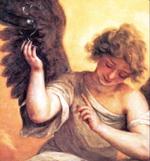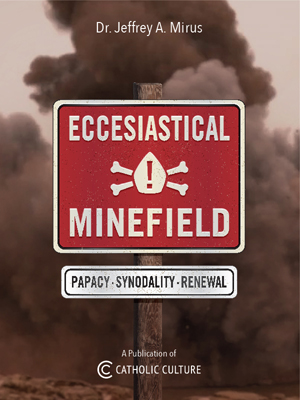Make your gift today!
Help keep Catholics around the world educated and informed.
Already donated? Log in to stop seeing these donation pop-ups.
Homily on St. Francis of Assisi (09-17-1993)
St. Francis' sole boast was the cross
On the mountain of La Verna close to the feast of the Triumph of the Cross in the year 1224, St. Francis of Assisi was marked with the wounds of Christ's passion. The shrine of La Verna has become a place of pilgrimage, and Pope John Paul II, "the pilgrim Pope", went there on 17 September, the feast of the Stigmatization on the Franciscan liturgical calendar. The Pope celebrated Mass in the Franciscan shrine and preached the homily in Italian as follows.
1. Behold the man "in whose time the house of God was renovated and in whose days the temple was reinforced" (Sir 50:1).
This man is named Francis: a "new man, sent to the world by heaven" (St. Bonaventure, Legenda maior, XII, 8).
We stand here in his footprints. Here the Poverello of Assisi walked. Here he revealed the great love burning in his heart, the love which made him resemble his Beloved, the Crucified: "I bear the marks of Jesus on my body" (Gal 6:17). Paul's words were wondrously fulfilled in him, and Umbria was witness to it. Also witness to it was this mountainous place which I have been able to visit today: La Verna!
2. Dear brothers and sisters, it was my intention to come and visit you last year but, as you know, it was not possible at that time. However, it is with great joy that I am here among you today. First of all, I greet Cardinal Silvano Piovanelli, Archbishop of Florence, Bishop Giovanni D'Ascenzi of this Diocese, the other prelates present, the priests and religious, the representatives of the various apostolic associations and movements. I greet the Mayor of Florence, a city which for centuries has been linked to La Verna for various reasons, and the representatives of the civil administration of this ancient mountainous town, which receives special prestige from its name, Chiusi della Verna.
A particular expression of my pleasure goes to the Order of Friars Minor in the persons of the Minister General and the Minister Provincial of Tuscany. I greet and thank for his welcome Fr. Eugenio Barelli, guardian of this sacred convent, as well as the other religious, all equally careful "to exercise hospitality" (Rom 12:13). Dear friars of La Verna, yours is the task of keeping St. Francis' presence alive in this place so that those who come up here can find in its authenticity the mystery of his configuration to Christ crucified which occurred right here in September, 1224 through the gift of the stigmata.
Francis embraced whole truth of Gospel paradox
3. The stigmata, the scars of Christ's passion on Francis' body, were the special sign which revealed the cross that he took up every day, in the most literal sense of the word. Did not Jesus say: "If anyone wishes to come after me, he must deny himself and take up his cross daily and follow me. Whoever loses his life for my sake will save it" (Lk 9:23-24)?
Francis embraced the whole truth of this paradox. The Gospel was his daily bread. He did not confine himself to reading its words, but through the expressions of the revealed text he set out to discover the One who is the Gospel itself. In fact, in Christ the divine economy is revealed in full: "losing" and "gaining" in their definitive, absolute sense. By his life Francis proclaimed and continues to proclaim today the saving word of the Gospel. It is difficult to find a saint whose message could withstand so deeply "the test of time".
Francis is the saint who is, in a certain sense, universal; through him Christ wanted to proclaim the Gospel not only to his era but to others as well, to our own age, to cultures and civilizations very different from one another.
Behold: he who "lost his life" for Christ "has saved it". He saved it in a wonderful way.
4. The stigmata which Francis received in this place, La Verna, are a particular sign. They are the deepest witness of the Poverello's truth.
See, we are presented with him who authentically and profoundly "boasted. . . of the cross of Christ". Not of anything else; solely "of the cross of our Lord Jesus Christ" (cf. Gal 6:14).
A sign of likeness in virtue of love. The Apostle Paul says this and Francis of Assisi repeats it: through Christ's cross and the power of love "the world has been crucified to me, and I to the world" (Gal 6:14).
The world does not want to be crucified: it flees the cross. People run away from being "crucified to the world". That is how it was in Francis' day, and it still is today. The struggle between the "world" and the cross goes on forever; it is a baffle with the cross of salvation!
It could, therefore, seem that Francis has become something of an irrelevant, useless witness. Whoever says to Christ: "My Lord are you, apart from you I have no good" (Ps 16:2) seems to offend the contemporary mentality. Indeed, man often does not acknowledge the Lord as being over him: he wants to be the master of himself and the world. This is why Francis' message is becoming an even greater sign of contradiction. A message of this kind should be rejected, yet it is increasingly sought after.
St. Francis strove to imitate Christ by self-denial
5. It is a message which is a pressing call to return to Christ, to rediscover in his cross "the path and the flame of truth" (St. Bonaventure, De triplici via III, 5): the truth which makes us free because it makes us disciples of the divine Master.
St. Francis' spiritual journey was marked by this faithful following of the God-Man, whom he strove to imitate without reserve in self-denial and total self-emptying (cf. Phil 2:7). This makes him, as St. Bonaventure says, "that most Christian pauper" par excellence (cf. Legenda major VIII, 5). This journey and following reached its climax on La Verna with the imprinting of the stigmata. That moment, even in the agony of his flesh, was his proclamation of victory, similar to what St. Paul referred to in the second reading we listened to a little while ago: "I bear the marks of Jesus on my body" (Gal 6:17).
The stigmatization on La Verna thus represents that visible conformity to the image of Christ which makes Francis the example to which every Christian can aspire in the process of drawing ever nearer to God the Creator and Redeemer. In this regard the words spoken by the Poverello at the end of his life are significant: "I have done my duty; may Christ teach you yours" (St. Bonaventure, Legenda major XIV, 3).
6. These words do not represent a self-satisfied introspection, but rather an offering of humble gratitude for what the Lord had done in him. Their meaning is nothing other than this: may Christ teach you, as he taught me, to be his disciples.
There are two lessons of the divine Master in particular that Francis followed with complete fidelity: obey the Pope, the Vicar of Christ on earth, venerate and imitate his most holy Mother Mary.(italics added)
The legitimation of his work in the Church, including the institution of a new religious order, depends entirely on the words of the first chapter of his rule: "Brother Francis promises obedience and reverence to the Lord Pope". In this same perspective, shortly before dying, he recommended to his brothers to "keep the faith of the holy Roman Church" (St. Bonaventure, Legenda major XIV, 5).
Then, too, St. Francis "embraced the mother of the Lord Jesus with an indescribable love" for having made "the Lord of Majesty our brother" and "after Christ he put all his trust in her" (St. Bonaventure, Legenda major IX, 3).
He imitated Mary in her meditative silence, especially after having been stamped by Christ, on this mountain, with the signs of his passion, thus showing that the greater the privileges God bestows, all the greater is the recipient's duty to conceal them. "The evangelical man, Francis", St. Bonaventure tells us, "came down from the mountain bearing with him the image of the Crucified. . . engraved in the members of his body by the finger of the living God"; "aware that he had been given a royal secret, to the best of his powers he kept the sacred stigmata hidden" (Legenda major XIII, 5).
Love alone can prevent the failure of humanity
7. "He protected his people against brigands and strengthened his city against the enemy" (Sir 50:4).
Dear brothers and sisters, this passage from the book of Sirach which we listened to at the beginning of Mass refers to Christ himself: in all circumstances he "protects his people". The cross has rooted him in human history; it has rooted him in human hearts.
"The world crucified" in Christ is always revealed anew as "the world loved": "For God so loved the world that he gave his only Son" (Jn 3:16). Francis bore witness to this boundless love and continues to do so even in our days.
Love alone can prevent the failure of humanity and the world: that world by which man is "besieged" and threatened in various ways.
8. Behold, we come to you, O Francis, in this place which was dear to you. We come to you to be strengthened once again in the conviction that love is greater than every negative power. We greet you at the end of the second Christian millennium! The Church and the whole human family salute you! And we pray to you, the Poverello of Assisi, "Strengthen the sanctuary in our day, too! Strengthen the Church! Amen.
This item 3076 digitally provided courtesy of CatholicCulture.org






